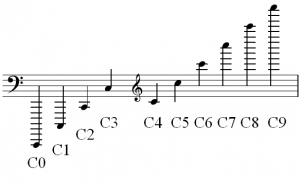I. Fundamentals
American Standard Pitch Notation (ASPN)
Chelsey Hamm and Bryn Hughes
Key Takeaways
- American Standard Pitch Notation (ASPN) provides labels for specific musical frequencies by combining a note name (such as C) with a subscript octave designation (such as 4).
- A pitch is a discrete tone with an individual frequency (e.g. C4), while a pitch class is less specific (e.g., C in general).
- ASPN differentiates between octaves, from C to B. The octaves are labeled from lowest to highest, beginning with 0 and continuing in ascending numerical order (1, 2, etc.).
- A piano keyboard primarily uses the ASPN octave designations 1 through 7, although small portions of octaves 0 and 8 are included.
- Middle C is C4 in ASPN. It is helpful to memorize the ASPN label of this note as a starting point.
American Standard Pitch Notation and Pitch versus Pitch Class
In order to discuss specific notes, or pitches, we will use American Standard Pitch Notation, abbreviated ASPN. ASPN designates specific musical pitches by combining a note name (such as C) with a subscript octave designation (such as 4), creating a bipartite label (for example, C4). ASPN labels are very useful, since they can identify every possible musical note within human hearing range, from the lowest pitches to the highest.
The Reading Clefs chapter introduced octave equivalence, the concept that explains why notes one or more octaves apart have the same letter name. Music theorists distinguish between a pitch, a discrete tone with an individual frequency (e.g. C4 using ASPN), versus a pitch class, which is less specific (e.g., C in general). A pitch class includes all the pitches with the same letter name, in any octave, along with their enharmonic equivalents. For example, all Cs are the same pitch class, and the enharmonically equivalent notes D𝄫 and B♯ are also part of the C pitch class; see Pitch and Pitch Class for more information. In this chapter we are naming specific pitches with ASPN.
ASPN and Octave Designations
ASPN differentiates between octaves, beginning with the pitch C and ending with the pitch B. This means that each new octave designation begins on the note C, as seen in Example 1. The octaves are labeled from lowest to highest, beginning with 0 and continuing in numerical order (1, 2, 3, etc.). The pitch middle C is C4, which is useful to memorize.

All letter names within an octave (below the C of the next octave) receive the same octave designation. For example, all of the notes in Example 2 would be designated in the 4 octave, because they are above C4 but below C5. Accidentals applied to a note do not have an effect on its ASPN number. For example, B♯3 and C4 have different octave numbers despite being enharmonically equivalent, because the B♯ is still considered part of the lower octave.

You can practice ASPN notation in all clefs in the following exercise:
ASPN and the Keyboard
ASPN labels are very helpful for finding specific notes on the piano keyboard. Example 3 depicts a piano keyboard with each octave labeled using ASPN notation. As you can see, the piano keyboard spans the full octaves 1 to 7. It also contains a small part of both octaves 0 and 8. ASPN labels are the same regardless of instrument or voice type. In other words, a C4 will always be labeled as such regardless of whether it is produced with a flute, trombone, violin, or voice.

ASPN and Staff Notation
Example 4 shows ASPN labels for common notes in the treble, bass, alto, and tenor clefs. Memorizing the location of C4 in each clef can make finding ASPN labels quicker and easier.
Example 4. ASPN labels for notes in four clefs.
- Clendinning, Jane Piper and Elizabeth West Marvin. 2021. The Musician’s Guide to Theory and Analysis, fourth edition. New York: W. W. Norton and Company.
- Hoover, Cynthia Adams and Edwin M. Good. 2013. “Piano.” Grove Music Online. https://doi.org/10.1093/gmo/9781561592630.article.A2257895
- “Pitches, Pitch Classes, Octave Designation, Enharmonic Equivalence” (YouTube)
- Tutorial on ASPN Octave Labels (liveabout.com)
- Tutorial on ASPN Octave Labels (flutopedia.com)
- Helpful Graphic with ASPN Labels on the Grand Staff and Piano (Music Theory Tips)
- Flash Cards with ASPN Labels in Treble and Bass Clefs (quizlet.com)
- ASPN Labels and Staff Notation (.pdf, .pdf)
- ASPN Labels, p. 25 (.pdf)
- ASPN Labels, Staff Notation, and the Piano Keyboard, p.1 (.pdf)
- American Standard Pitch Notation (ASPN) (.pdf, .mscz). Asks students to identify pitches by ASPN label and write pitches in the correct octave from ASPN labels.
- American Standard Pitch Notation (ASPN), Treble and Bass Clef (.pdf, .mscz). Asks students to identify pitches by ASPN label and write pitches in the correct octave from ASPN labels. No C clefs.
Media Attributions
- Octave Designations © Wikimedia Commons is licensed under a Public Domain license
- Octave 4 ASPN Labels © Chelsey Hamm is licensed under a CC BY-SA (Attribution ShareAlike) license
- Piano ASPN Labels © AlwaysAngry adapted by Megan Lavengood is licensed under a Public Domain license
Designates specific musical frequencies by combining a note name (such as C) with an octave designation (such as 4), creating a bipartite label (C₄).
A discrete tone with an individual frequency.
A group of pitches that are octave equivalent and enharmonically equivalent.
An interval of twelve half steps between two notes with the same letter name. The frequencies of two notes related by octave form a 2:1 ratio. Abbreviated “8ve.”
C₄; the C near the middle of the piano keyboard, written on the first ledger line below the treble clef staff or the first ledger line above the bass clef staff.
A relationship between pitches that share a letter name but are separated by one or more octaves.

